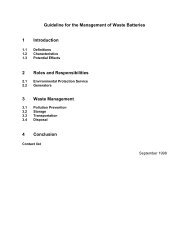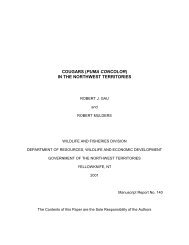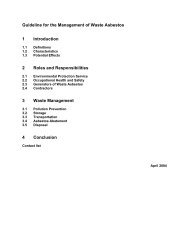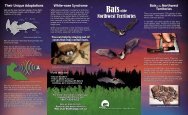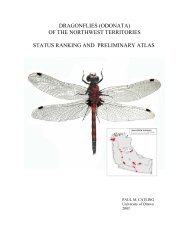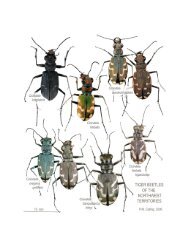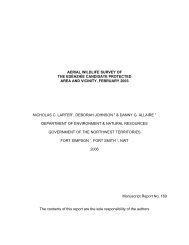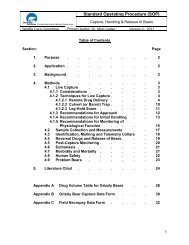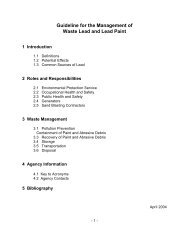NWT Air Quality Report (2011) - Environment and Natural ...
NWT Air Quality Report (2011) - Environment and Natural ...
NWT Air Quality Report (2011) - Environment and Natural ...
Create successful ePaper yourself
Turn your PDF publications into a flip-book with our unique Google optimized e-Paper software.
OPERATIONS (NETWORK)The <strong>NWT</strong> <strong>Air</strong> <strong>Quality</strong> Monitoring Network consists of four permanent monitoring stationslocated in Yellowknife, Inuvik, Fort Liard <strong>and</strong> Norman Wells. The stations are climatecontrolledtrailers <strong>and</strong> include state-of-the-art monitoring equipment capable of continuouslysampling <strong>and</strong> analyzing a variety of air pollutants <strong>and</strong> meteorological conditions. Pollutantsmonitored vary by station, but include sulphur dioxide (SO 2), hydrogen sulphide (H 2S), fineparticulate (PM 2.5), coarse particulate (PM 10), ground level ozone (O 3), carbon monoxide (CO)<strong>and</strong> nitrogen oxides (NO x). Wind speed, wind direction <strong>and</strong> temperature are also monitored.For additional information on air pollutants, see Appendix B.INUVIKYUKONNORMANWELLSNUNAVUTSNARE RAPIDSYELLOWKNIFEFORT LIARD<strong>NWT</strong><strong>Air</strong> Monitoring StationFigure 1: Map of the <strong>Air</strong> <strong>Quality</strong> Monitoring Network4 <strong>NWT</strong> <strong>Air</strong> <strong>Quality</strong> <strong>Report</strong> <strong>2011</strong>
Table 2 presents the various government affiliations involved with the air quality monitoringstations in the <strong>NWT</strong>.Table 2 – <strong>NWT</strong> <strong>Air</strong> <strong>Quality</strong> NetworkPartnership/ContractStationsNetworkYellowknife<strong>and</strong> Inuvik<strong>Environment</strong>CanadaEnvironnementCanadaNational <strong>Air</strong> PollutionSurveillance<strong>Environment</strong> <strong>and</strong><strong>Natural</strong> Resources –<strong>Environment</strong>DivisionFort Liard <strong>and</strong>Norman WellsNorthwest Territoriesstations<strong>NWT</strong> PowerCorporationSnare Rapids<strong>Environment</strong>CanadaEnvironnementCanadaCanadian <strong>Air</strong> <strong>and</strong>Precipitation Monitoring<strong>Air</strong> quality monitoring in the <strong>NWT</strong> has evolved over time, beginning with a singleTSP monitor in Yellowknife back in 1974, <strong>and</strong> progressing through various monitoringlocations <strong>and</strong> equipment to reach the current stage of development.Appendix A traces the history of air quality monitoring in the <strong>NWT</strong>, while previousENR Annual <strong>Air</strong> <strong>Quality</strong> <strong>Report</strong>s can be found at http://www.enr.gov.nt.ca/_live/pages/wpPages/<strong>Air</strong>_<strong>Quality</strong>.aspx<strong>NWT</strong> <strong>Air</strong> <strong>Quality</strong> <strong>Report</strong> <strong>2011</strong>7
Developmentsin <strong>2011</strong>Many upgrades were conducted throughout the network in <strong>2011</strong> to remain current withmonitoring technology advancements <strong>and</strong> to conform with the NAPS operating st<strong>and</strong>ards:• A non-continuous particulate sampler was installed at the Yellowknife station in <strong>2011</strong>. Thisinstrument is a manual partisol dichotomous sampler <strong>and</strong> is operated on a 24-hour runtime,every six days. This filter-based instrument is the Federal Reference Method (FRM)<strong>and</strong> allows for speciation of the particulate.• The PM 2.5BAM at the Inuvik station was replaced with a BAM FEM, similar to Yellowknife’supgrade in 2010, which conforms with the ‘federal equivalency method’. The NAPSnetwork has moved toward upgrading all PM 2.5monitors to this FEM st<strong>and</strong>ard.• The data acquisition <strong>and</strong> management system was upgraded in <strong>2011</strong> for three of thefour stations. This included upgrading DRDAS software <strong>and</strong> installing PC-based industrialloggers at the Yellowknife, Norman Wells <strong>and</strong> Inuvik stations. The new loggers replacedthe analog Campbell Scientific data-loggers, which had operated since the stations’inceptions in 2003. This system allows ENR remote access to the stations for selectfeatures, including access to diagnostic information, re-booting options <strong>and</strong> the ability toactivate certain calibration features.8 <strong>NWT</strong> <strong>Air</strong> <strong>Quality</strong> <strong>Report</strong> <strong>2011</strong>
Future PlansENR plans to conduct the following updates to the <strong>Air</strong> <strong>Quality</strong> Monitoring Network in 2012:• Finalize the upgrade of the air quality data acquisition <strong>and</strong> management system forFort Liard.• Launch an improved <strong>Air</strong> <strong>Quality</strong> Monitoring Network website, which provides more userfriendlyfeatures in accessing current <strong>and</strong> historic data <strong>and</strong> associated statistics.• Replace the SO 2<strong>and</strong> CO analyzers in Yellowknife with analyzers capable of trace-leveldetection.<strong>NWT</strong> <strong>Air</strong> <strong>Quality</strong> <strong>Report</strong> <strong>2011</strong>9
<strong>NWT</strong> <strong>Air</strong><strong>Quality</strong> St<strong>and</strong>ardsThe Government of the <strong>NWT</strong> has adopted a number of concentration limits for protection ofambient (outdoor) air quality in the <strong>NWT</strong>. These limits apply to select pollutants <strong>and</strong> are containedin the “Guideline for Ambient <strong>Air</strong> <strong>Quality</strong> St<strong>and</strong>ards in the Northwest Territories”, establishedunder the <strong>NWT</strong> <strong>Environment</strong>al Protection Act. They are summarized in Table 3 below.The <strong>NWT</strong> st<strong>and</strong>ards are used in the assessment of air quality monitoring data as well asdetermining the acceptability of emissions from proposed <strong>and</strong> existing developments. Where<strong>NWT</strong> st<strong>and</strong>ards are not available for a particular pollutant, the Canadian National Ambient <strong>Air</strong><strong>Quality</strong> Objectives (national st<strong>and</strong>ards) or limits established in other jurisdictions are used.Table 3 – <strong>NWT</strong> Ambient <strong>Air</strong> <strong>Quality</strong> St<strong>and</strong>ardsParameter <strong>and</strong> St<strong>and</strong>ardSulphur Dioxide (SO 2)1-hour average24-hour averageAnnual arithmetic meanConcentration(μg/m 3 )*45015030Concentration(ppbv)**Ground Level Ozone (O 3)8-hour running average 130 65Total Suspended Particulate (TSP)24-hour averageAnnual geometric mean12060Fine Particulate Matter (PM 2.5)24-hour average 30Nitrogen Dioxide (NO 2)1-hour average24-hour averageAnnual arithmetic meanCarbon Monoxide (CO)1-hour average8-hour average* Micrograms per cubic metre** Parts per billion by volume4002006015,000 (15mg/m 3 )6,000 (6mg/m 3 )17257112131063213,0005,000The “Guideline for Ambient <strong>Air</strong> <strong>Quality</strong> St<strong>and</strong>ards in the Northwest Territories” providesadditional information on the application of the <strong>NWT</strong> st<strong>and</strong>ards <strong>and</strong> the pollutants ofconcern. For additional information on air pollutants, see Appendix B.10 <strong>NWT</strong> <strong>Air</strong> <strong>Quality</strong> <strong>Report</strong> <strong>2011</strong>
Figure 3 shows the monthly averages <strong>and</strong> maximum daily average per month, measuredat the Sir John Franklin station in <strong>2011</strong> on the FEM BAM PM 2.5. The highest daily averageconcentration was 45.8μg/m 3 , measured in July.Figure 4: 2007 - 2010 Summary Yellowknife Hourly PM 2.516(μg/m 3 )Monthly Average Concentration14121086420J F M A M J J A S O N D2008 2009 2010 <strong>2011</strong>Figure 4 summarizes the monthly average BAM PM 2.5data over the last four years. Theoverall trends indicate that PM 2.5levels increase during the summer months, which istypically attributed to forest fires that occur during this time of year. As the graph indicates,the <strong>2011</strong> fire season was similar to those of previous years, with the exception of 2008,which had a more severe season.Coarse Particulate (PM 10)The <strong>NWT</strong> does not have a st<strong>and</strong>ard for PM 10, but instead adopts a 24-hour average criterionof 50µg/m 3 . This level is used in several Canadian jurisdictions, including BC, Ontario <strong>and</strong>Newfoundl<strong>and</strong> <strong>and</strong> Labrador.<strong>NWT</strong> <strong>Air</strong> <strong>Quality</strong> <strong>Report</strong> <strong>2011</strong>13
The graph in Figure 5 presents the PM 10data for <strong>2011</strong> <strong>and</strong> clearly shows the annual ‘dust’event, which is typical mainly for the month of April. This is due to residual gravel on theroads following the spring snow thaw. There were thirteen exceedances of the adoptedst<strong>and</strong>ard of 50µg/m 3 in <strong>2011</strong>. The majority of these occurred in April <strong>and</strong> correlate well withthe springtime “dust event”. The other exceedances occurred during the months of June<strong>and</strong> July <strong>and</strong> were attributed to the previously mentioned smoke from forest fires.Figure 5: <strong>2011</strong> Yellowknife BAM PM 1060.0(μg/m 3 )140.0Monthly Average50.040.030.020.010.0120.0100.080.060.040.020.0Maximum Daily Average0.0J F M A M J J A S O N D0.0Monthly AverageMaximum Daily AverageFigure 5 shows the BAM PM 10monthly averages <strong>and</strong> maximum daily averages per monthmeasured at the Yellowknife station in <strong>2011</strong>. The highest maximum daily concentration was127.9μg/m 3 , occurring in April.Sulphur Dioxide (SO 2)Continuous monitoring for SO 2has been conducted in Yellowknife at several locations since1992, primarily to monitor the effects from the former gold mine operations. The current SO 2monitoring location at the Sir John Franklin station has been in place since 2004.There were no exceedances of the <strong>NWT</strong> hourly (450μg/m 3 ) or 24-hour (150μg/m 3 ) st<strong>and</strong>ardsin <strong>2011</strong> in Yellowknife. The annual average was less than 2μg/m 3 , a level that is well belowthe <strong>NWT</strong> (30μg/m 3 ) st<strong>and</strong>ard.14 <strong>NWT</strong> <strong>Air</strong> <strong>Quality</strong> <strong>Report</strong> <strong>2011</strong>
Nitrogen Dioxide (NO 2)The NO xgas analyzer provides continuous information on NO, NO 2<strong>and</strong> NO x. However, thefocus is on NO 2due to the greater health concerns associated with this pollutant <strong>and</strong> theavailability of national air quality st<strong>and</strong>ards for comparison (see Appendix B).The <strong>2011</strong> results indicated that there were no exceedances of the 1-hour, 24-hour or annual<strong>NWT</strong> st<strong>and</strong>ards for NO 2(400, 200, 60 μg/m 3 , respectively). The maximum 1-hour average was84μg/m 3 , the maximum 24-hour average was 38μg/m 3 , while the annual average was 7μg/m 3 .Figure 9: 2010 YellowknifeNitrogen Dioxide(μg/m 3 )90Concentration80706050403020100J F M A M J J A S O N DMonthly Average24-hour Maximum1-hour MaximumFigure 10: <strong>2011</strong> YellowknifeNitrogen Dioxide(μg/m 3 )90J F M A M J J A S O N DMonthly Average24-hour Maximum1-hour MaximumFigures 9 <strong>and</strong> 10 show the 2010 <strong>and</strong> <strong>2011</strong> maximum hourly, maximum daily <strong>and</strong> monthlyaverages of NO 2in Yellowknife. Generally, both the highest monthly averages <strong>and</strong> thehighest hourly concentrations occurred during the winter months. This is likely caused byincreased emissions from fuel combustion for residential <strong>and</strong> commercial heating <strong>and</strong> idlingvehicles as well as short-term ‘rush hour’ traffic influences. The effects of these emissionsConcentration80706050403020100<strong>NWT</strong> <strong>Air</strong> <strong>Quality</strong> <strong>Report</strong> <strong>2011</strong>17
on winter-time air quality can be increased when combined with stagnant meteorologicalconditions. Cold, calm days can result in an atmospheric situation where the normaldecrease in air temperature with elevation is reversed <strong>and</strong> a zone of colder air is present atground level. This zone of colder air <strong>and</strong> the lack of wind act to restrict dispersion <strong>and</strong> trappollutants close to the ground.Carbon Monoxide (CO)The <strong>2011</strong> data continued the extremely low CO readings measured in 2010 <strong>and</strong> were wellbelow the <strong>NWT</strong> 1-hour <strong>and</strong> 8-hour average st<strong>and</strong>ards (15mg/m 3 <strong>and</strong> 6mg/m 3 respectively).In <strong>2011</strong>, the maximum 1-hour average was 2.4 mg/m 3 <strong>and</strong> the annual average was 0.3 mg/m 3 .Given the absence of heavy traffic volumes in Yellowknife, low levels of CO are expected.Figure 11: <strong>2011</strong> Yellowknife Carbon Monoxide(mg/m 3 )3.02.5Concentration2.01.51.00.50.0J F M A M J J A S O N DMonthly Average 1-hour Maximum Maximum 8-hour AverageFigure 11 shows the <strong>2011</strong> monthly averages <strong>and</strong> highest hourly concentrations for COin Yellowknife.18 <strong>NWT</strong> <strong>Air</strong> <strong>Quality</strong> <strong>Report</strong> <strong>2011</strong>
InuvikAIR QUALITYThe focus of the monitoring station in Inuvik is togather baseline community air quality information<strong>and</strong> to track trends <strong>and</strong> cumulative effects ofpollutant sources over time. In January 2006,the station was incorporated into the National <strong>Air</strong>Pollution Surveillance (NAPS) Network to provideair quality information for comparison to othercommunities in Canada.This station has been in operation since 2003, butwas moved from its original location at SamuelHearne School to its present site on BompasStreet in 2009. The following parameters aremeasured at the Inuvik station: PM 2.5, PM 10, SO 2,O 3, NO 2<strong>and</strong> H 2S.Figure 12: Inuvik StationFine Particulate (PM 2.5)Due to logger issues following installation of the BAM FEM PM 2.5, erroneous readings wererecorded throughout the year as a result of a programming code malfunction. As a result,the data over this time period was invalidated, leaving only a data set of January, November<strong>and</strong> December of <strong>2011</strong>. This monitoring period does not cover the summer forest fireseason, where PM 2.5readings typically experience elevations.Figure 13: <strong>2011</strong> Inuvik BAM PM 2.56.0(μg/m 3 )16.05.014.012.0Monthly Average4.03.02.01.010.08.06.04.02.0Maximum Daily Average0.0J F M A M J J A S O N D0.0Monthly AverageMaximum Daily Average<strong>NWT</strong> <strong>Air</strong> <strong>Quality</strong> <strong>Report</strong> <strong>2011</strong>19
Coarse Particulate (PM 10)The maximum daily average measured from the PM 10BAM in Inuvik in <strong>2011</strong> was 96.3μg/m 3 ,recorded in May. The highest hourly maximum was 308.4μg/m 3 <strong>and</strong> occurred in July. Therewere 15 exceedances of the adopted 24-hour st<strong>and</strong>ard (50µg/m 3 ), which generally occurredin the snow-free months. Similar to previous years, the spring-time levels were elevated <strong>and</strong>were representative of the typical ‘spring-time dust event’ associated with residual wintergravel. Given the dirt roads in the Inuvik area in proximity to the monitoring station, the dustevents can persist into the summer months as well.Figure 14: <strong>2011</strong> Inuvik BAM PM 1040.0(μg/m 3 )200.0Monthly Average35.030.025.020.015.010.05.0180.0160.0140.0120.0100.080.060.040.020.0Maximum Daily Average0.0J F M A M J J A S O N D0.0Monthly AverageMaximum Daily AverageFigure 14 shows the monthly averages <strong>and</strong> the maximum daily average concentrationsof PM 10from the BAM in Inuvik. The spring spike is attributed to the residual winter gravelon the roads following the thaw, while the summer elevations are likely attributed to acombination of the forest fires burning in the Inuvik area in June, July <strong>and</strong> August, <strong>and</strong> thepresence of dirt roads in proximity to the station.20 <strong>NWT</strong> <strong>Air</strong> <strong>Quality</strong> <strong>Report</strong> <strong>2011</strong>
Nitrogen Dioxide (NO 2)The NO 2results for Inuvik in <strong>2011</strong> show that the maximum 1-hour average was 88μg/m 3 ,the maximum 24-hour average was 38μg/m 3 <strong>and</strong> the overall annual average was 5μg/m 3 , allof which were within the <strong>NWT</strong> st<strong>and</strong>ards (400, 200, 60 μg/m 3 , respectively).Figure 16: <strong>2011</strong> Inuvik Nitrogen Dioxide(μg/m 3 )1009080706050403020100J F M A M J J A S O N DMonthly Average 1-hour Maximum 24-hour MaximumConcentrationFigure 16 shows the maximum hourly, maximum daily <strong>and</strong> monthly averages of NO 2in Inuvikin <strong>2011</strong>. Average concentrations are observed to be higher in the colder months, similar toprevious years, likely as a result of idling <strong>and</strong> other combustion sources during inversions(stagnant air masses).Hydrogen Sulphide (H 2S)The data collected in <strong>2011</strong> continues to indicate very low H 2S concentrations in Inuvik –essentially non-detectable. Most of the readings are less than 1μg/m 3 , which is below thedetectable limits of the instrumentation <strong>and</strong> within the ‘noise’ range.The maximum recorded 1-hour average was 5μg/m 3 , while the maximum 24-hour averagewas 2μg/m 3 . There were no exceedances of the adopted Alberta guidelines (1-hour average14μg/m 3 <strong>and</strong> a 24-hour average of 4μg/m 3 ). These results are consistent with the readingscollected in previous years.22 <strong>NWT</strong> <strong>Air</strong> <strong>Quality</strong> <strong>Report</strong> <strong>2011</strong>
fort liardAIR QUALITYThe focus of the monitoring station in Fort Liardis to gather baseline community air qualityinformation <strong>and</strong> to track trends <strong>and</strong> cumulativeeffects of pollutant sources over time.The station is located near the Fort Liard <strong>Air</strong>port<strong>and</strong> measures PM 2.5, PM 10, SO 2, O 3, NO 2<strong>and</strong>H 2S. Monitoring has been conducted for selectparameters since 2000; however, this station wasestablished in 2004. Note that the O 3analyzer wasinstalled in 2007.Fine Particulate (PM 2.5)The <strong>2011</strong> annual PM 2.5average concentration was4.6μg/m 3 , while the maximum daily average was 25.8μg/m 3 . There were no exceedances ofthe <strong>NWT</strong> 24-hour st<strong>and</strong>ard for PM 2.5(30μg/m 3 ).Figure 17: <strong>2011</strong> Fort Liard BAM PM 2.59.08.07.0(μg/m 3 )30.025.0Monthly Average6.05.04.03.02.01.020.015.010.05.0Maximum Daily Average0.0J F M A M J J A S O N D0.0Monthly AverageMaximum Daily AverageFigure 17 shows the monthly averages <strong>and</strong> maximum daily averages for PM 2.5measuredfrom the BAM at the Fort Liard station in <strong>2011</strong>. The slightly elevated readings in the summermonths are typical <strong>and</strong> reflect the dusty roads <strong>and</strong> forest fire events in the region.<strong>NWT</strong> <strong>Air</strong> <strong>Quality</strong> <strong>Report</strong> <strong>2011</strong>23
Coarse Particulate (PM 10)The highest daily maximum for PM 10was 66.4μg/m 3 , recorded in May, <strong>and</strong> it was also theonly exceedance of the adopted 24-hour st<strong>and</strong>ard (50µg/m 3 ). Results were not available forthe months of April <strong>and</strong> October due to issues with tape changes. Elevated PM 10readingswere measured from May until September, which represent the snow-free months of theyear <strong>and</strong> are attributed to the presence of gravel roads throughout Fort Liard. These resultsare expected <strong>and</strong> are consistent with previous years.Figure 18: <strong>2011</strong> Fort Liard BAM PM 1025.0(μg/m 3 )70.0Monthly Average20.015.010.05.00.0J F M A M J J A S O N D60.050.040.030.020.010.00.0Maximum Daily AverageMonthly AverageMaximum Daily AverageFigure 18 shows the monthly averages <strong>and</strong> the maximum daily average concentrations ofPM 10measured from the BAM in Fort Liard in <strong>2011</strong>.Sulphur Dioxide (SO 2)As in previous years, there were no exceedances of the <strong>NWT</strong> hourly (450μg/m 3 ), 24-hour(150μg/m 3 ) or annual average (30μg/m 3 ) st<strong>and</strong>ards for SO 2in Fort Liard, with a maximum1-hour average value of only 5μg/m 3 . The monthly averages were very low, with values lessthan 2μg/m 3 . These readings are consistent with those measured in previous years.Ground Level Ozone (O 3)Ozone data in Fort Liard was invalidated in <strong>2011</strong> due to an instrument <strong>and</strong> data acquisitionmalfunction.24 <strong>NWT</strong> <strong>Air</strong> <strong>Quality</strong> <strong>Report</strong> <strong>2011</strong>
Norman Wells<strong>Air</strong> <strong>Quality</strong>The focus of the monitoring station in NormanWells is to gather baseline community air qualityinformation <strong>and</strong> to track trends <strong>and</strong> cumulativeeffects of pollutant sources over time.The station is located at the ENR compound onForestry Drive <strong>and</strong> measures PM 2.5, PM 10, SO 2, O 3,NO 2<strong>and</strong> H 2S. It has been in operation since 2003.Fine Particulate (PM 2.5)The maximum daily average concentration of PM 2.5in Norman Wells in <strong>2011</strong> was 22.1μg/m 3 <strong>and</strong> theannual average was 4.7μg/m 3 . There were noexceedances of the <strong>NWT</strong> 24-hour st<strong>and</strong>ard forPM 2.5(30μg/m 3 ). The elevated readings measured in June <strong>and</strong> July are attributed to dustyconditions in June <strong>and</strong> smoke from forest fires burning near Fort Good Hope, Délı̨ne <strong>and</strong> at25 Mile Lake in the month of July.Figure 20: <strong>2011</strong> Norman Wells BAM PM 2.58.0(μg/m 3 )25.0Monthly Average7.06.05.04.03.02.01.020.015.010.05.0Maximum Daily Average0.0J F M A M J J A S O N D0.0Monthly AverageMaximum Daily AverageFigure 20 shows the monthly averages <strong>and</strong> maximum daily averages of PM 2.5measuredfrom the BAM at the Norman Wells station in <strong>2011</strong>. The elevated readings in the summerare typical <strong>and</strong> are associated with the forest fire season.26 <strong>NWT</strong> <strong>Air</strong> <strong>Quality</strong> <strong>Report</strong> <strong>2011</strong>
Coarse Particulate (PM 10)The <strong>2011</strong> year represents the first full year in which PM 10data was collected in NormanWells. The 1-hour maximum concentration was 327.6μg/m 3 , which occurred in May duringthe spring-time ‘dust’ event. The 24-hour maximum concentration was 80.4μg/m 3 <strong>and</strong> theannual average concentration was 18.1μg/m 3 . There were 11 exceedances of the adopted24-hour average st<strong>and</strong>ard of 50μg/m 3 .Figure 21: <strong>2011</strong> Norman Wells BAM PM 10Monthly Average40.035.030.025.020.015.010.05.00.0(μg/m 3 )J F M A M J J A S O N D90.080.070.060.050.040.030.020.010.00.0Maximum Daily AverageMonthly AverageMaximum Daily AverageFigure 21 shows the monthly averages <strong>and</strong> the maximum daily average concentrationsof PM 10measured from the BAM in Norman Wells in <strong>2011</strong>. The snow-free months wereaffected by dusty conditions throughout the summer from the gravel roads <strong>and</strong> constructionactivities.Sulphur Dioxide (SO 2)Overall, SO 2concentrations in Norman Wells were generally very low. The 1-hour maximumSO 2reading was 5μg/m 3 , the maximum 24-hour average was 3μg/m 3 <strong>and</strong> the annualaverage was less than 2μg/m 3 . No exceedances of the <strong>NWT</strong> st<strong>and</strong>ards occurred (1-houraverage of 450μg/m 3 , 24-hour average of 150μg/m 3 <strong>and</strong> annual average of 30μg/m 3 ). This isconsistent with previous years.<strong>NWT</strong> <strong>Air</strong> <strong>Quality</strong> <strong>Report</strong> <strong>2011</strong>27
Ground Level Ozone (O 3)The maximum 1-hour average was 110µg/m 3 , while the maximum 8-hour average was106µg/m 3 , both occurring in May. Neither the 1-hour national maximum acceptable level(160µg/m 3 ) nor the 8-hour <strong>NWT</strong> st<strong>and</strong>ard (130µg/m 3 ) for ground level ozone was exceededin <strong>2011</strong>. The annual average was 46µg/m 3 , which is within the range of what is consideredbackground levels. The typical elevated readings in the spring-time were observed, which isconsistent with historical data.Figure 22: <strong>2011</strong> Norman Wells Ozone(μg/m 3 )120100Concentration806040200J F M A M J J A S O N DMonthly Average 1-hour Maximum Maximum 8-hour AverageFigure 22 shows the maximum hourly <strong>and</strong> maximum 8-hour average per month as well asthe monthly averages for ground level ozone recorded in Norman Wells in <strong>2011</strong>.28 <strong>NWT</strong> <strong>Air</strong> <strong>Quality</strong> <strong>Report</strong> <strong>2011</strong>
Nitrogen Dioxide (NO 2)The <strong>2011</strong> NO 2results for Norman Wells show that the maximum 1-hour average was42μg/m 3 , the maximum 24-hour average was 13μg/m 3 <strong>and</strong> the overall annual average was2μg/m 3 , which were within the <strong>NWT</strong> st<strong>and</strong>ards (400, 200, 60 μg/m 3 , respectively).Figure 23: <strong>2011</strong> Norman Wells Nitrogen DioxideConcentration(μg/m 3 )454035302520151050J F M A M J J A S O N DMonthly Average 1-hour Maximum 24-hour MaximumFigure 23 shows the <strong>2011</strong> monthly averages, maximum 24-hour averages <strong>and</strong> maximum1-hour concentrations of NO 2in Norman Wells. As with previous years, NO 2levels wereobserved to increase in the winter months as a function of idling <strong>and</strong> other combustionsources during inversions (stagnant air masses).Hydrogen Sulphide (H 2S)The maximum hourly H 2S concentration in <strong>2011</strong> was 2μg/m 3 <strong>and</strong> the vast majority ofreadings were less than 1μg/m 3 , essentially within the detection limits or ‘noise’ range of theanalyzer. The maximum 24-hour average was 2μg/m 3 . H 2S in Norman Wells was within thelimits of the adopted Alberta guidelines (1-hour average of 14μg/m 3 <strong>and</strong> a 24-hour averageof 4μg/m 3 ). The <strong>2011</strong> results are consistent with previous years.<strong>NWT</strong> <strong>Air</strong> <strong>Quality</strong> <strong>Report</strong> <strong>2011</strong>29
Snare RapidsSince 1989, ENR has operated a Canadian <strong>Air</strong> <strong>and</strong> Precipitation Monitoring (CAPMoN)station at the Northwest Territories Power Corporation’s Snare Rapids hydro site. This site islocated 150 kilometres northwest of Yellowknife. Rain <strong>and</strong> snow samples are collected on adaily basis <strong>and</strong> sent to <strong>Environment</strong> Canada’s CAPMoN laboratory in Toronto for analysis ofprecipitation chemistry. Select results are presented below.Figure 24: Snare Rapids Acid Deposition (1993 - <strong>2011</strong>)(kg/ha/year)1.61.41.210.80.60.40.2093 94 95 96 97 98 99 00 01 02 03 04 05 06 07 08 09 10 11Sulphate Nitrate Calcium MagnesiumFigure 24 shows the deposition rates for sulphate, calcium, nitrate <strong>and</strong> magnesium from1993 to <strong>2011</strong>.The geology of the <strong>NWT</strong> is mostly characterized by non-carbonate bedrock resistant toweathering <strong>and</strong>/or shallow, coarse-textured soils with low cation exchange capacity, lowsulphate adsorption capacity <strong>and</strong> low pH. The sulphate level of deposition that is consideredto be protective of sensitive ecosystems in the <strong>NWT</strong> is 7 kg/ha/yr. In areas of easternCanada where acid rain is a more serious environmental problem, sulphate deposition hasbeen measured by CAPMoN in excess of 20 kg/ha/yr. Nitrate deposition at Snare Rapids isalso low relative to eastern Canada.Sulphate <strong>and</strong> nitrate deposition rates measured at Snare Rapids remain below levels thatwould be expected to cause a significant environmental effect in sensitive ecosystems.30 <strong>NWT</strong> <strong>Air</strong> <strong>Quality</strong> <strong>Report</strong> <strong>2011</strong>
Appendix A:Monitoring HISTORYHistory of <strong>Air</strong> <strong>Quality</strong> Monitoring in the Northwest Territories1974 • Government of the <strong>NWT</strong> starts monitoring air quality in Yellowknife with theinstallation of a high-volume air sampler at the Post Office site.1989 • Monitoring of acid precipitation at the Snare Rapids hydro-electric site begins.1992 • SO 2analyzer installed at the City Hall site.1997 • SO 2monitoring in N’dilo begins <strong>and</strong> continues until 2000.1998 • O 3analyzer added in Yellowknife to the City Hall site.2000 • A SO 2analyzer was installed in the ENR building in Fort Liard in March, followedby a H 2S analyzer in October.2002 • Daring Lake summer sampling of PM 10begins.• City Hall SO 2analyzer relocated to new air monitoring trailer located at Ècole SirJohn Franklin High School.2003 • Daring Lake summer sampling of PM 2.5begins (the same sampler is used forPM 10<strong>and</strong> PM 2.5monitoring).• <strong>Air</strong> monitoring trailers are installed in Inuvik, Norman Wells <strong>and</strong> Fort Liard.• CO <strong>and</strong> NO xanalyzers added to the Yellowknife station as well as a continuousfine particulate sampler (PM 2.5).• Norman Wells station monitors SO 2<strong>and</strong> H 2S.• Inuvik station monitors SO 2, H 2S, NO x<strong>and</strong> PM 2.5.• Fort Liard station monitors SO 2<strong>and</strong> H 2S. A PM 2.5sampler is installed late in theyear.• The O 3analyzer that was operating at the Yellowknife City Hall location isrelocated to the new Sir John Franklin station.• ENR initiates the upgrade of the Data Acquisition System moving to aspecialized air monitoring system, which will allow more efficient <strong>and</strong> qualitycontrolled data collection.• Continuous PM 2.5samplers are installed in Inuvik <strong>and</strong> Fort Liard.• A second high-volume sampler is installed at the Sir John Franklin station inYellowknife.2004 • PM 2.5sampler is installed in Norman Wells.• Data Acquisition System (DAS) is significantly upgraded. New components areinstalled inside the stations <strong>and</strong> a new data management, analysis <strong>and</strong> reportingsystem is brought on-line.<strong>NWT</strong> <strong>Air</strong> <strong>Quality</strong> <strong>Report</strong> <strong>2011</strong>31
History of <strong>Air</strong> <strong>Quality</strong> Monitoring in the Northwest Territories (cont.)2005 • NO xanalyzer is installed in March at the Fort Liard station.• O 3<strong>and</strong> NO xanalyzers are installed at the Norman Wells station in April.• O 3analyzer purchased by <strong>Environment</strong> Canada (Yellowknife office) is installed atthe Inuvik station in April.• Due to years of significant data loss caused by extreme cold, the partisoldichotomous fine particulate sampler at the Yellowknife Post Office station isrelocated indoors at the Sir John Franklin station.• The Yellowknife Post Office station is officially closed after the last TSP sampleran on December 6, 2005.• Development of an <strong>Air</strong> <strong>Quality</strong> web site begins. The web site will link with thedata management, analysis <strong>and</strong> reporting system to provide public access to airquality data for each monitoring location. Access to archived data will also beavailable by querying the database using web-based tools.2006 • Yellowknife – A BAM particulate matter (PM 10) monitor is installed <strong>and</strong> beginscollecting data in April.• Inuvik – A BAM particulate matter (PM 10) monitor is installed <strong>and</strong> beginscollecting data in October.• The <strong>Air</strong> <strong>Quality</strong> Monitoring Network web site is officially released.2007 • Fort Liard – A BAM particulate matter (PM 10) monitor <strong>and</strong> an ozone (O 3) analyzerare installed <strong>and</strong> begin collecting data in late August.• Completed the second phase of the <strong>Air</strong> <strong>Quality</strong> Monitoring Network website, which included database related modifications as well as web designimprovements.2008 • No significant changes to the network.2009 • Norman Wells – PM 10BAM installed to complete particulate samplingthroughout the network.• Yellowknife – Hi-vol sampler discontinued from all NAPS stations.• Daring Lake particulate monitoring temporarily discontinued due to malfunction.2010 • Norman Wells – PM 10BAM installation completed.• Inuvik – Entire station is relocated to a more representative location due toongoing construction activities in the original location.• Yellowknife – PM 2.5monitor upgraded to BAM FEM (Federal EquivalencyMethod).<strong>2011</strong> • Inuvik – PM 2.5monitor upgraded to BAM FEM (Federal Equivalency Method)• Data acquisition <strong>and</strong> management system upgraded in Yellowknife, NormanWells <strong>and</strong> Inuvik, including Envista ARM software <strong>and</strong> PC-based industrial dataloggers.• Manual partisol dichotomous sampler installed in Yellowknife.• BAMs at all stations begin reporting in actual conditions instead of STP, as perfederal protocol.32 <strong>NWT</strong> <strong>Air</strong> <strong>Quality</strong> <strong>Report</strong> <strong>2011</strong>
Appendix B:<strong>Air</strong> PollutantsThe <strong>NWT</strong> <strong>Air</strong> <strong>Quality</strong> Monitoring Network tracks a number of different air pollutants. Withthe exception of H 2S, these pollutants are known as Criteria <strong>Air</strong> Contaminants (CACs).They represent the gases <strong>and</strong> compounds most often affecting community air quality <strong>and</strong>targeted by monitoring programs.H 2S is monitored at the air quality stations in Inuvik, Norman Wells <strong>and</strong> Fort Liard due to itsassociation with oil <strong>and</strong> gas development activities.Total Suspended Particulate (TSP)Total Suspended Particulate (TSP) is a general term for dust. TSP includes a wide varietyof solid <strong>and</strong> liquid particles found floating in the air, with a size range of approximately50 micrometers (µm) in diameter <strong>and</strong> smaller (a human hair is approximately 100 µm indiameter). While TSP can have environmental <strong>and</strong> aesthetic impacts, it is the smallerparticles contained within TSP that are of concern from a human health perspective (seeParticulate Matter (PM 2.5) <strong>and</strong> (PM 10) later in section). Road dust, forest fires, mining activities<strong>and</strong> combustion products from vehicles, heating <strong>and</strong> electricity generation contribute to TSPlevels.The <strong>NWT</strong> Ambient <strong>Air</strong> <strong>Quality</strong> St<strong>and</strong>ard for TSP is 120μg/m 3 over a 24-hour period. Thest<strong>and</strong>ard for the annual average is 60µg/m 3 (geometric mean).Particulate Matter (PM 2.5) <strong>and</strong> (PM 10)A sub-portion of TSP, these very small particulates are named for the diameter size ofthe particles contained within each group – PM 10contains particles with a diameter of 10microns (1 millionth of a metre) or less, while PM 2.5(a sub-portion of PM 10) contains particleswith a diameter of 2.5 microns or less. The significance of these microscopic particles is thatthey can be inhaled <strong>and</strong> are associated with health effects, including aggravation of existingpulmonary <strong>and</strong> cardiovascular disease. Generally, the smaller the particle, the greater thepenetration into the lung <strong>and</strong> the greater the associated health risk.Sources of particulates that can be inhaled include road dust <strong>and</strong> wind-blown soil, whichmake up the majority of the PM 10particles. Particles in the PM 2.5size range primarily resultfrom combustion of fossil fuels for industrial activities, commercial <strong>and</strong> residential heatingas well as vehicle emissions, forest fire smoke <strong>and</strong> chemical reactions between other gasesemitted to the air.<strong>NWT</strong> <strong>Air</strong> <strong>Quality</strong> <strong>Report</strong> <strong>2011</strong>33
The national Canada-wide St<strong>and</strong>ards (CWS) process has set an acceptable limit for PM 2.5,but has not yet established a limit for PM 10. The CWS 24-hour average acceptable limit forPM 2.5is 30µg/m 3 <strong>and</strong> this concentration has been adopted under the <strong>NWT</strong> <strong>Environment</strong>alProtection Act as the <strong>NWT</strong> Ambient <strong>Air</strong> <strong>Quality</strong> St<strong>and</strong>ard for PM 2.5. Several Canadianjurisdictions (e.g. BC, Ontario, Newfoundl<strong>and</strong> <strong>and</strong> Labrador) have adopted a PM 10concentration of 50µg/m 3 (24-hour average) as an acceptable limit.Sulphur Dioxide (SO 2)SO 2is a colourless gas, with a pungent odour at elevated concentrations, which can havenegative effects on human <strong>and</strong> environmental health. Certain types of vegetation (especiallylichens) are very sensitive to SO 2impacts. SO 2also plays a role in acid deposition <strong>and</strong>formation of secondary fine particulate through chemical reactions with other pollutants inthe air.There are some natural sources of SO 2in ambient air (forest fires, volcanoes), but humanactivity is the major source. Emissions of SO 2primarily result from the burning of fossil fuelscontaining sulphur. Sources include natural gas processing plants, gas plant flares <strong>and</strong>oil refineries, metal ore smelting, power generating plants <strong>and</strong> commercial or residentialheating.The <strong>NWT</strong> Ambient <strong>Air</strong> <strong>Quality</strong> St<strong>and</strong>ards for SO 2are 450 µg/m 3 (1-hour average), 150 µg/m 3(24-hour average) <strong>and</strong> 30 µg/m 3 (annual average).Hydrogen Sulphide (H 2S)Hydrogen sulphide (H 2S) is a colourless gas with a characteristic rotten egg odour. Athigh concentrations (parts per million range), it can be toxic, but typical ambient (outdoor)concentrations, even in areas impacted by industrial sources, tend to fall in the parts perbillion (ppb) range. However, due to its low odour threshold, the presence of H 2S can beoffensive <strong>and</strong> it has been associated with eye irritation <strong>and</strong> triggering feelings of nausea insensitive individuals.Industrial sources include oil <strong>and</strong> gas extraction, petroleum refining, sewage treatmentfacilities, <strong>and</strong> pulp <strong>and</strong> paper mills. <strong>Natural</strong> sources include sulphur hot springs, swamps<strong>and</strong> sloughs, which release H 2S as a by-product of organic decomposition.There are no <strong>NWT</strong> st<strong>and</strong>ards for H 2S. The Alberta Ambient <strong>Air</strong> <strong>Quality</strong> Objectives providean hourly limit of 14μg/m 3 (or 10ppb) <strong>and</strong> a 24-hour limit of 4μg/m 3 (or 3ppb), based onavoidance of odour.34 <strong>NWT</strong> <strong>Air</strong> <strong>Quality</strong> <strong>Report</strong> <strong>2011</strong>
Nitrogen Oxides (NO X)Nitrogen oxides (NO x) consist of a mixture of nitrogen-based gases, primarily nitric oxide(NO) <strong>and</strong> nitrogen dioxide (NO 2). Emissions of both NO <strong>and</strong> NO 2results from the hightemperature combustion of fossil fuels. The predominant emission is NO, which then rapidlyconverts to NO 2through chemical reaction in the atmosphere. NO is a colourless <strong>and</strong>odourless gas, whereas NO 2is a reddish-brown colour with a pungent, irritating odour. NO 2is considered the more toxic <strong>and</strong> irritating of the two gases <strong>and</strong>, at elevated concentrations,is associated with both acute <strong>and</strong> chronic respiratory effects. Both gases play a role in theatmospheric reactions resulting in acid deposition <strong>and</strong> secondary pollutant formation (i.e. O 3<strong>and</strong> fine particulate).Because of the greater health effects of NO 2, development of air quality st<strong>and</strong>ards hasfocused on this gas, rather than NO or total NO x. The <strong>NWT</strong> st<strong>and</strong>ards are reflective ofnational maximum desirable levels of 400μg/m 3 (1-hour average), 200μg/m 3 (24-houraverage) <strong>and</strong> 60μg/m 3 (annual average).Ground Level Ozone (O 3)Ground level ozone (O 3) should not be confused with stratospheric O 3, which occurs atmuch higher elevations <strong>and</strong> forms a shield that protects life on the planet from the sun’sharmful ultraviolet radiation. The gas is the same, but at ground level O 3is regarded asundesirable due to its association with a variety of human health concerns, environmentalimpacts <strong>and</strong> property damage. O 3is a highly reactive gas <strong>and</strong> is defined as a secondarypollutant. It is not emitted in large quantities from any source, but is formed through a seriesof complex chemical reactions involving other pollutants called precursors (e.g. NO x<strong>and</strong>volatile organic compounds or VOCs) in the presence of sunlight.The national st<strong>and</strong>ards provide a maximum acceptable level of 160μg/m 3 for O 3based ona 1-hour average. The Canada-wide St<strong>and</strong>ards (CWS) process has also set an acceptablelimit of 65ppb or 130μg/m 3 based on an 8-hour average. The CWS 8-hour limit has beenadopted under the <strong>NWT</strong> <strong>Environment</strong>al Protection Act as the <strong>NWT</strong> Ambient <strong>Air</strong> <strong>Quality</strong>St<strong>and</strong>ard for O 3.Carbon Monoxide (CO)Carbon monoxide (CO) is a colourless, odourless <strong>and</strong> tasteless gas produced by theincomplete combustion of fuels containing carbon. The primary source is vehicle exhaust,especially in cities with heavy traffic congestion. Other sources include industrial processes<strong>and</strong> fuel combustion for building heating. One natural source is wildfires.<strong>NWT</strong> <strong>Air</strong> <strong>Quality</strong> <strong>Report</strong> <strong>2011</strong>35
CO affects humans <strong>and</strong> animals by interfering with the ability of the blood to transportoxygen around the body.The <strong>NWT</strong> st<strong>and</strong>ards for CO reflect the national maximum desirable levels of 15mg/m 3(1-hour average) <strong>and</strong> 6mg/m 3 (8-hour average). CO values are reported in mg/m 3 asopposed to other gaseous pollutants, which are reported in μg/m 3 .Acid DepositionAcidity in precipitation is measured in pH units on a scale of 0 to 14. A value of sevenindicates neutral, values less than seven indicate acidic conditions <strong>and</strong> values greater thanseven indicate alkaline conditions. Even clean precipitation is slightly acidic – aroundpH5.6 – due to the presence of naturally occurring concentrations of carbon dioxide <strong>and</strong>minor amounts of sulphate <strong>and</strong> nitrate ions. The introduction of sulphur dioxide <strong>and</strong> nitrogenoxide emissions from combustion of fossil fuels for industrial, commercial <strong>and</strong> individualactivities can result in an increase in acidic compounds in the atmosphere – often in areasfar removed from the original emission sources. The removal of these sulphur <strong>and</strong> nitrogencompounds through atmospheric washout is reflected in the increased acidity (lower pHvalues) of precipitation. Calcium <strong>and</strong> magnesium ions – mostly from natural sources – act toneutralize acidity in precipitation.Generally, precipitation with a pH value of 5.0 or less is termed ‘acidic’. However,assessment of acid precipitation is usually based on deposition to an area over a specifiedtime period (e.g. kilograms per hectare per year, kg/ha/yr) rather than review of specificprecipitation event parameters. Also, the degree of impact to a particular environmentis influenced by its ‘buffering’ capacity or ability to tolerate the acidic inputs. Therefore,determination of acceptable limits usually requires a range of values to reflect the differingtolerances of various areas.36 <strong>NWT</strong> <strong>Air</strong> <strong>Quality</strong> <strong>Report</strong> <strong>2011</strong>
<strong>NWT</strong> <strong>Air</strong> <strong>Quality</strong> <strong>Report</strong> <strong>2011</strong>37



